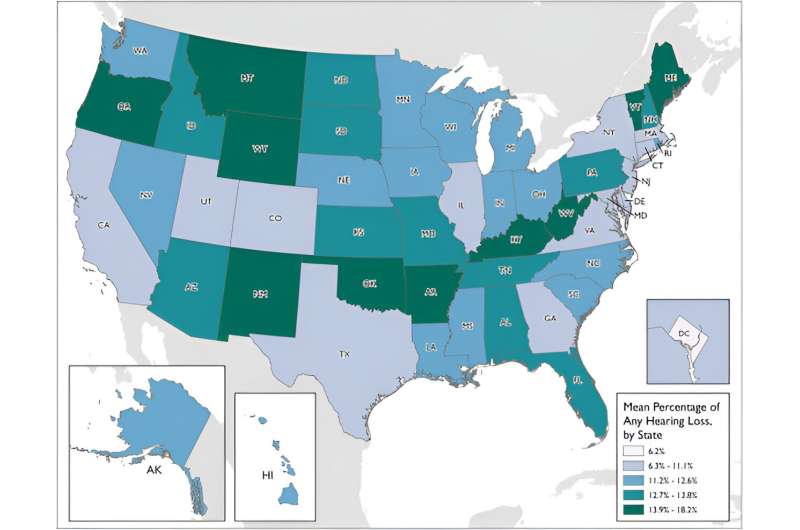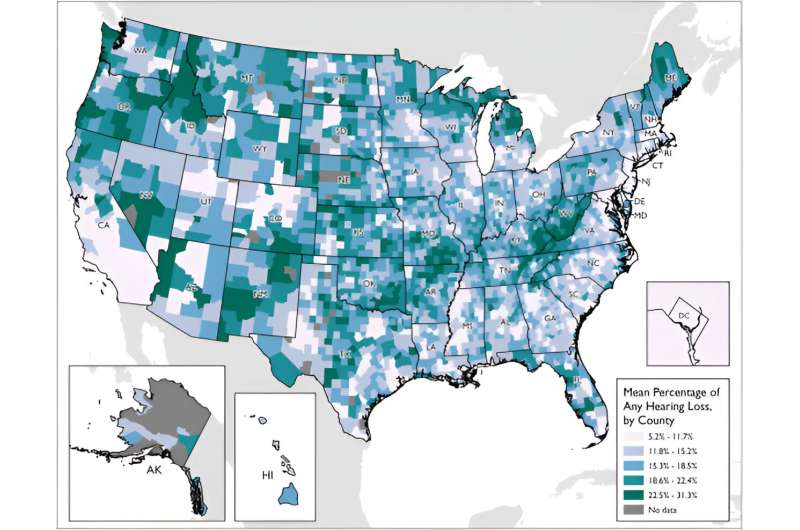This article has been reviewed according to Science X's editorial process and policies. Editors have highlighted the following attributes while ensuring the content's credibility:
fact-checked
trusted source
proofread
Jobs and geography may affect hearing: New study maps hearing loss by state and county across the US

The first study to map the prevalence of bilateral hearing loss in the United States by state and county finds that rates of hearing loss are higher among men, non-Hispanic whites, and residents of rural areas. Bilateral hearing loss is hearing loss in both ears.
West Virginia, Alaska, Wyoming, Oklahoma, and Arizona had the highest rates of hearing loss, while the District of Columbia, New Jersey, New York, Maryland, and Connecticut had the lowest.
The researchers identified that the occupations most associated with hearing loss besides mining were in retail and restaurant settings. They also found that hearing loss increases significantly starting at age 35.
The prevalence research supporting the map development was published in The Lancet Regional Health—Americas.
The Sound Check study, conducted by researchers at NORC at the University of Chicago, found that nearly 38 million Americans—more than 1 in 9—suffer from some form of bilateral hearing loss. The rate increases to just under 1 in 7 for people ages 35 and older and 1 out of every 1.4 people ages 75 and older.
"These results emphasize the importance of hearing loss as a national concern," said David Rein, senior fellow at NORC at the University of Chicago and the principal investigator of the study. "The number one risk factor for hearing loss is aging, but the map tells us that where you live impacts your hearing as well. Surprisingly, people living in urban areas with large populations and traffic noise have less hearing loss prevalence than people in rural areas."
The good news is that there are ways to prevent or reduce the chances of hearing loss caused by noise exposure by using hearing protection. When significant hearing loss does occur, hearing aids and other treatments and adaptations can help people improve their quality of life.
"What the public needs to know is that hearing is as important to your health as clear vision. Getting glasses is not a big deal, but neither is getting hearing aids or wearing hearing protection when it's needed," said Donna Smiley, Ph.D., CCC-A, chief staff officer for Audiology at the American Speech-Language-Hearing Association (ASHA). "People should ask their doctor about screening for hearing loss and how to protect their hearing."
The Sound Check study researchers note that because their findings estimate hearing loss by state and by county, the estimates can be used to target hearing loss prevention, diagnosis, and treatment strategies.
"We hope that public health officials across the country make it a priority to advocate for improved screening for adults just as they have for newborns and young children. This study and the map show that hearing loss needs attention, and that prevention may be possible," according to Karl White, director of the National Center for Hearing Assessment and Management, Utah State University.

People in rural areas may be at higher risk for hearing loss because of noise exposure from outdoor work using heavy machinery and from recreational activities involving all-terrain vehicles or the use of firearms for hunting and recreation. Consistent use of hearing protection can reduce the risk of hearing loss, even among people who engage in recreational firearm use.
Hearing loss has serious impacts on health and quality of life—inhibiting speech and language development in children, elevating family stress, and contributing to work and social problems among adults. In older adults, hearing loss is also associated with higher risk of dementia, depression, falls, heart attack, and premature death.
"We need to recognize the impact that hearing loss has on our emotional, social, and cognitive health. In many cases, hearing loss can be prevented and almost all forms of hearing loss can be successfully treated so that people can enjoy their lives without straining to hear what others are saying," Smiley said.
More on hearing loss
Despite its high prevalence, hearing loss in the U.S. is undertreated. Possible reasons for this include poor access to hearing health care, the lack of universal coverage—or coverage at all—of hearing technologies by insurance and Medicare, the stigma associated with wearing hearing aids, and lack of awareness and understanding of hearing loss.
The negative effects of hearing loss can be reduced with a variety of amplification devices including hearing aids and cochlear implants. For people with mild-to-moderate hearing loss, over-the-counter hearing aids are an option. However, access to hearing specialists can be difficult for people living in rural or impoverished areas and the cost of hearing aids, even over-the-counter devices, may be beyond the reach of many people.
Exposure to loud noise is the most common cause of preventable hearing loss. At any age, listening to sounds that are too loud for too long can permanently damage a person's hearing. Although most hearing loss due to noise occurs from repeated or long-term exposure to loud noise, even a one-time exposure without hearing protection to an extremely loud noise—like a gunshot—can cause hearing loss. Unprotected exposure to other short bursts of loud noise, such as fireworks from three feet away, or to painful, steady noises, such as a jackhammer or jet plane takeoff, can also damage a person's hearing.
Although most hearing loss is permanent and cannot be reversed, noise-related hearing loss can be prevented by avoiding loud noises and wearing hearing protection.
The Sound Check project estimated the national prevalence of hearing loss in both ears based on the audiology examination module of the National Health and Nutrition Examination Survey (NHANES). Results were stratified by age, race and ethnicity, and gender. To generate state and county estimates, the researchers used a statistical modeling approach called small area estimation to predict variation in hearing loss in different geographical areas using county data for other indicators of hearing loss.
More information: David B. Rein et al, The prevalence of bilateral hearing loss in the United States in 2019: a small area estimation modelling approach for obtaining national, state, and county level estimates by demographic subgroup, The Lancet Regional Health—Americas (2024). DOI: 10.1016/j.lana.2023.100670




















